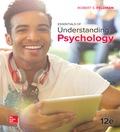
To match: Each of the following organizational laws with its meaning.
Answer to Problem 1E
Correct answer:
| a. Closure | 3. Groupings are made in terms of complete figures. |
| b. Proximity | 1. Elements close together are grouped together. |
| c. Similarity | 4. Elements similar in appearance are grouped together. |
| d. Simplicity | 2. Patterns are perceived in the most basic, direct manner possible. |
Explanation of Solution
a. Closure- 3. Groupings are made in terms of complete figures.
The tendency of humans to organize stimuli into some coherent groups is termed as grouping. The rules for grouping were identified by the Gestalt psychologists. The four principles that are valid for visual stimuli are closure, proximity, similarity, and simplicity. The principle of closure involves the grouping of elements in order to form complete or enclosed figures rather than the open ones.
b. Proximity- 1. Elements close together are grouped together.
The perceived elements that are closer together are grouped together in the Gestalt principle of proximity. For example: an individual see a pair of dots rather than a row of single dots.
c. Similarity- 4. Elements similar in appearance are grouped together.
The perceived elements that are alike in their appearance are grouped together in the Gestalt principle of similarity. For example: individual see horizontal rows of squares and circles rather than vertical mixed columns.
d. Simplicity- 2. Patterns are perceived in the most basic, direct manner possible.
The observed patterns that are perceived in the most basic, straightforward manner are called the Gestalt principle of simplicity.
Want to see more full solutions like this?
Chapter 11 Solutions
EBK ESSENTIALS OF UNDERSTANDING PSYCHOL
- Identify applicable scenarios and examples observed ‘in action’ during your class behavior. Provide an analysis of psychological theory, themes, and concepts evident in the work observed during class. What theoretical framework is used to understand/explain what occurred in your experiences?arrow_forwardwhat makes the candomble tradition stand out?arrow_forwardby observing behavior students in class , what your thoughts about the effectiveness and purpose of the work being done there?arrow_forward
- When would using checklists and rating scales be most appropriate in early childhood? Use scholarly sources.arrow_forwardI need help with two articles are there any similarities and differences between the two https://www.phnompenhpost.com/business/indian-ambassador-pledges-increased-trade-tourismpromotion, https://time.com/5486460/pol-pot-cambodia-1979/arrow_forwardEvaluate the application of behaviourism and cognitive psychological perspectives to contemporary issues in psychology.arrow_forward
- Analyse the similarities and the differences between behaviourism and cogniperspectives in psychology.arrow_forwardEvaluate the work of key theorists Neisser, 1967 relating to congnitive psychological perspectivearrow_forwardEvaluate the work of key theorists John B. Watson and B.F. Skinner relating to behaviourismarrow_forward
 Ciccarelli: Psychology_5 (5th Edition)PsychologyISBN:9780134477961Author:Saundra K. Ciccarelli, J. Noland WhitePublisher:PEARSON
Ciccarelli: Psychology_5 (5th Edition)PsychologyISBN:9780134477961Author:Saundra K. Ciccarelli, J. Noland WhitePublisher:PEARSON Cognitive PsychologyPsychologyISBN:9781337408271Author:Goldstein, E. Bruce.Publisher:Cengage Learning,
Cognitive PsychologyPsychologyISBN:9781337408271Author:Goldstein, E. Bruce.Publisher:Cengage Learning, Introduction to Psychology: Gateways to Mind and ...PsychologyISBN:9781337565691Author:Dennis Coon, John O. Mitterer, Tanya S. MartiniPublisher:Cengage Learning
Introduction to Psychology: Gateways to Mind and ...PsychologyISBN:9781337565691Author:Dennis Coon, John O. Mitterer, Tanya S. MartiniPublisher:Cengage Learning Psychology in Your Life (Second Edition)PsychologyISBN:9780393265156Author:Sarah Grison, Michael GazzanigaPublisher:W. W. Norton & Company
Psychology in Your Life (Second Edition)PsychologyISBN:9780393265156Author:Sarah Grison, Michael GazzanigaPublisher:W. W. Norton & Company Cognitive Psychology: Connecting Mind, Research a...PsychologyISBN:9781285763880Author:E. Bruce GoldsteinPublisher:Cengage Learning
Cognitive Psychology: Connecting Mind, Research a...PsychologyISBN:9781285763880Author:E. Bruce GoldsteinPublisher:Cengage Learning Theories of Personality (MindTap Course List)PsychologyISBN:9781305652958Author:Duane P. Schultz, Sydney Ellen SchultzPublisher:Cengage Learning
Theories of Personality (MindTap Course List)PsychologyISBN:9781305652958Author:Duane P. Schultz, Sydney Ellen SchultzPublisher:Cengage Learning





